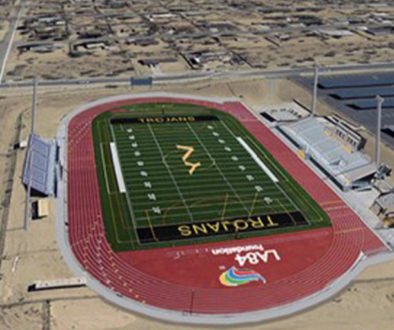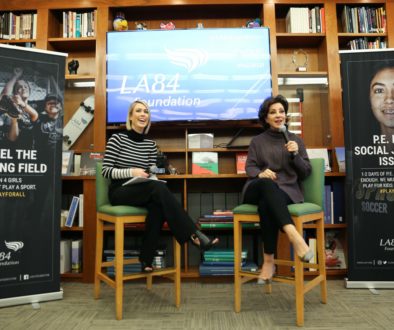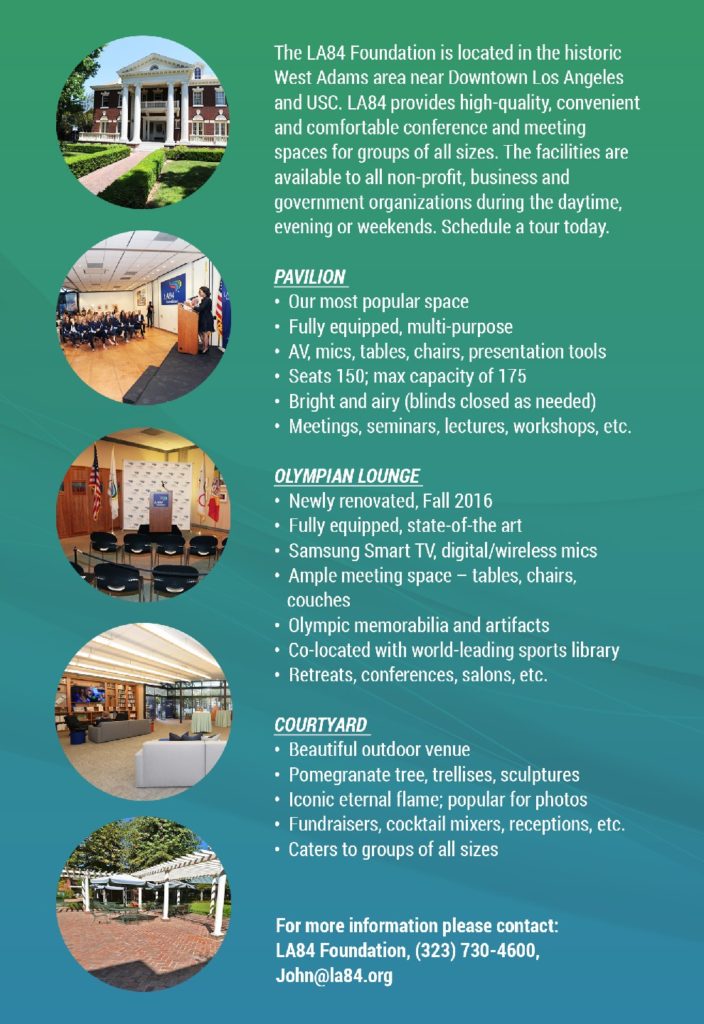SportsLetter Interview: Jeré Longman Talks About His New Book on Louisiana High School Football Post-Katrina
In August of 2005, when Hurricane Katrina struck the Gulf Coast of the United States, one of the most devastated areas was Plaquemines Parish, the southernmost parish of Louisiana. Located where the Mississippi River meets the Gulf of Mexico, Plaquemines Parish is the hub of the region’s vital commercial fishing industry. After Katrina, many of its residents, including its school children, were scattered throughout the nation.
As the community began to regroup post-Katrina, three area schools were combined into South Plaquemines High School. The students on the football team (nicknamed the Hurricanes) had to put aside their past rivalries in order to form a new, cohesive unit. The Hurricanes soon became a symbol of revival in southern Louisiana, even as its players faced myriad challenges: they had no locker-room or home field; their school didn’t have electricity; many lived in sub-standard and crowded FEMA trailers, often without their families.
New York Times reporter Jeré Longman, a Louisiana native, first journeyed to Plaquemines Parish in 2006 to write about the Hurricanes for the newspaper. He returned the following year as the team surged toward the state championship. The title game was played at the Louisiana Superdome, symbol of the chaotic incompetence during and after Hurricane Katrina.
Longman has just published “The Hurricanes: One High School Team’s Homecoming After Katrina” (PublicAffairs; Amazon). The book details the two-year recovery process in Plaquemines Parish, as seen and experienced by the players, the coaches and their families. The result is, at once, heartbreaking and uplifting: it’s “Friday Night Lights” comes to the bayou. Recently, SportsLetter interviewed Longman via telephone from his home in Philadelphia.
— David Davis
SportsLetter: How did you come to write this book?
Jeré Longman: The day Katrina hit, the Times sent a lot of Louisiana natives down to New Orleans to cover the story. I got a call from the assistant sports editor saying, “There must be a great high school football story – go and find one.” It was obvious, by the time I got down there, that there was going to be no high school football for the immediate future. So, I worked throughout the autumn of 2005 for the Times’ national desk. On the first anniversary of Katrina, in 2006, I called my editor at the Times and said, “Look, there’s a new high school being formed in Plaquemines Parish and they’re going to play football. What do you think?” They said, “Well, we’ve got a lot of anniversary stories. Why don’t you just follow them through the year and write a few stories at the end of the season?” When I got down there, as always happens, they said, “Just start writing now.” For that, I’m eternally grateful because I ended up writing nine or ten stories during that first season. In the spring of 2006, I went to the first graduation at South Plaquemines High to see the kids one more time, just to see them off. They had their spring football game the day before graduation, and the coach kept saying to me, “We’re going to win the state championship next year. You should come back.” So, I did. I kept going back. I’m lucky the Times worked with me. I was allowed to do a lot of Louisiana-related stories for them, and that allowed me to go back down there. Sometimes, I went down on my own.
SL: You were raised in southwestern Louisiana. How far, distance-wise, is that area from Plaquemines Parish?
JL: Except for the first three months of my life, I grew up in a town called Eunice, Louisiana, which is two-and-a-half hours west-northwest of New Orleans, in the Cajun part of Louisiana. Eunice is about three hours west-northwest of Plaquemines Parish.
SL: How different is Eunice, culturally, from the towns in Plaquemines Parish?
JL: They’re not so dissimilar. There’s a lot of French influence in Plaquemines Parish. There’s a Cajun radio station that broadcasts from a nearby parish. There are some differences: it’s on the water, and I grew up inland. But in both places there’s a lot of fishing and hunting going on as well as eating good Cajun food.
SL: What did you know about Plaquemines Parish before Katrina?
JL: Before Katrina, I had never been to Plaquemines Parish, which begins seven miles south of New Orleans. Many people, even those in New Orleans, don’t know much about it. It’s 70 miles long and had, before Katrina, 27,000 people. The Mississippi River bisects the peninsula and runs into the Gulf. There’s one road in and out – Highway 23. On one side of the road is the Mississippi River, the other side is the marsh of the Gulf. It’s a very tenuous location. It’s an unknown, but amazingly vital area. Actually, what I knew about it was that, for much of the last half of the 20th century, the parish was run by this political family dynasty, the Perez family, who were arch-segregationists. The patriarch, Leander, was a judge and district attorney, and then his two sons succeeded him.
SL: You covered the team’s 2006 season for the Times, then returned in 2007 to complete the book. What differences did you notice from 2006 to 2007?
JL: In 2006, when South Plaquemines High opened, everything was brand new. Some people thought the school wasn’t ready at that point: the students didn’t have all their books, they didn’t have walkways over the sidewalks. But there was an effort, an urgency, to get the schools started again. The first day I showed up, they were tearing down the library and you could see all these waterlogged books. There were coffins waiting to go back into the ground. Even now there are coffins waiting to get put back into the ground. They’ve cleaned up a lot of debris since 2006. By 2007, more businesses were opening. More people were coming back to live. They’re not in homes; a lot of them are in trailers. That makes more sense because it’s so tenuous down there. A lot of people feel that, if they’re going to lose everything again, they might as well be in a trailer. The big difference with the football team in 2006 was that they had to travel 60 miles roundtrip to practice every day. Their own field wasn’t ready until the very end of the season. Even through the 2007 season they had no locker room. They used a makeshift locker room in the destroyed gym of another, ruined school. The coach used a generator to power the lights. Occasionally, they’d be dressing and a rat or a possum would run out of the locker room. This current season, they finally have turned an activity room in the school into a locker room.
SL: The kids survived myriad traumas, including displacement after Katrina, sub-standard living conditions in FEMA trailers, separation from their families, lack of adequate practice facilities. How were they able to cope with all of the chaos in their lives?
JL: One kid told me, in 2006, something that I had never considered. He said that, having come back there from evacuating elsewhere in Louisiana, lower Plaquemines Parish was the one place where you didn’t really have to talk about Katrina because everybody had lost everything. You didn’t have to explain yourself because everybody was in the exact same boat that you were, so everyone understood what you had gone through. In many ways, the epicenter of the hurricane was the one place where you didn’t have to talk about it. It was obvious every time you looked out the door what had happened. In that sense, that helped them cope once they came back.
SL: What do you think was the most difficult challenge for them to overcome?
JL: Losing their homes and having to live in FEMA trailers was a huge challenge. They were constantly wondering whether their family would be able to rebuild their homes and whether they would get insurance to rebuild. Those were big issues. But it was also just trying to get some semblance of normalcy back in their lives. Some of these kids were living without parents; some were driving 50 miles a day. They were living in these small FEMA trailers, people living on top of each other, and that led to a lot of tension. And, underneath everything, there was this uncertainty about what would happen when the next hurricane came.
SL: What did being able to play football mean to them?
JL: Football brought a sense of familiarity to these kids. It meant some semblance of a life that they recognized was back. They were going to school every day on a ruined campus, where everything was destroyed. And yet, they still had football. When everything else around them was destroyed, this was something that they could be successful at. This told them, if we can rebuild this team, maybe we’ll be okay. Football really anchored the community. Football on Friday nights became a common meeting-point where people could get together and talk: “How was your week? What happened with FEMA? How’s the insurance?” In a larger sense, when they won the state championship, it gave people in the community an idea that, if the football team can do it, maybe we can too. Many times in sports I think that idea is over-subscribed, that too much is given to the possibility of sport and what a team can do for a community. In this case, I think it’s true: the kids led the way for the community. When everything else failed, they were a measurable success that people could rally around.
SL: How important was it that the team went on to win the state championship in 2007?
JL: The coach, Cyril Crutchfield, had won a state championship with one of the destroyed schools back in 2002. From the first day of practice, he never felt that just fielding a team was okay. He was determined, even in 2006, to win the state championship. In retrospect, that was a dream way beyond their reach, but they were determined from day one to be very successful. His attitude was, “So what if everything else was destroyed; football is still going to succeed.” He’s not from there – he brought an attitude of achievement that not everybody down there has – and I think his own personal determination elevated everybody else along with him.
SL: How about for you as a writer: how important was it that the team won the state title?
JL: I’ll say that it was important to sell the book that they won the state championship. That kind of lent a certain legitimacy to the team. But for me as a writer, that wasn’t important. For me it was the struggle itself, watching what these kids dealt with, that was so incredible. My book previous to this was about the futility of being a Philadelphia Eagles fan [“If Football’s a Religion, Why Don’t We Have a Prayer? Philadelphia, Its Faithful, and the Eternal Quest for Sports Salvation”]. It was about the year they went to the Super Bowl, when they had Terrell Owens. With that one, it was almost better that they didn’t win the Super Bowl because the futility continued. But, in this case, when you’re trying to sell a book, it helps that the story ends with a championship.
SL: The coach, Cyril Crutchfield, is a central character of the book. He’s demanding, dedicated and emotional – but he also slaps players and curses them. Was it difficult for you to paint an objective portrait of Crutchfield?
JL: No. He was just like every high school coach I played for. I grew up in that culture. To be honest with you, that’s the way most coaches are, whether they admit it or not. He might do some things I wouldn’t do, but I was just trying to portray him as he was. I didn’t set out to judge him, just to portray him as he was and let people make up their own minds. The kids don’t seem to mind him, nor do the parents.
SL: Do you think that his style was uniquely suited for that group of kids? Would you want your kid to be coached by him?
JL: Yeah, I wouldn’t mind having my kid coached by him. There will be a debate about this obviously – whether you should be allowed to smack kids or curse and stuff like that. But that’s who he is. He’s an operatic kind of guy. You can agree or disagree with his methods. But if it was so traumatic for these kids, I don’t think they would’ve won the state championship.
SL: How is the team doing this season and how did some of the players you wrote about fare?
JL: They’re ranked number one in the state this year among small schools. They’ve lost one game, against a school that has four times its enrollment. They haven’t given up a point in their last four games, and they’re favored to win the state championship again. Two kids from the 2007 team got college scholarships, to a small NAIA school. The star running back, who’s still in high school, has a scholarship offer from Louisiana Tech. The quarterback hasn’t committed yet, but I think that he has a college scholarship offer. Maybe they’ll come back to live in the parish, but this way some of these kids can see a broader life, a little bit of the world.
SL: There’ve been many season-in-the-life books about sports teams. Why did you decide to embark on a two-year journey?
JL: I didn’t know this when I started out, but disaster-related books and high school football-related books don’t sell well generally. To be honest with you, I couldn’t find anybody that was interested in it in 2006. Even in 2007 I couldn’t find anybody who was interested in it until I had finished about 75 percent of the book. But I was determined. I knew that this was a great story and that if nobody bought it, I would just publish it on the Internet. I didn’t care. At that point, I was just hoping somebody would pay me enough for my expenses. So, to answer your question: I kept going back to Plaquemines because I thought it was a good story. I’m grateful that my publisher, PublicAffairs, decided it was a worthy book.
SL: How about previous books on high school sports: what books from that sub-genre did you draw from or relate to?
JL: “Friday Night Lights,” by my former colleague Buzz Bissinger, is obviously the king of that genre. It’s a classic book about the mania for Texas football. I read “The Courtship of Marcus DuPree,” by Willie Morris, when it came out. That was a great book about a superbly talented athlete who happened to come from a small town – Philadelphia, Mississippi – that endured a tragic moment during the Civil Rights Era. There was another book, called “Hurricane Season” [by Neal Thompson], written about a private school in New Orleans that won the state championship the same year that Katrina hit. That’s probably one reason why I had difficulty selling mine, just because there was another book already out. But the two books were different. That was about a school that went to the state championship every year.
SL: You had great access – with the players and the coaches on the team – and you take readers into the unique lifestyle of Plaquemines Parish. Do you think this sort of life will survive? What’s the future of the region?
JL: That’s the $64,000 question. It’s a very tenuous future. Some scientists say that the parish could be split into islands if there’s another big hurricane. The coastal erosion is a huge problem. Many scientists believe that, if you’re not creating new marshland in the next decade or so, then all of these places will have to be abandoned because the towns are, literally, sinking. Some people argue that you shouldn’t live down there anymore. But there’s such a sense of place there. The people who are there grew up there, and they’re not going to leave.
SL: How did Plaquemines Parish survive during the 2008 hurricane season?
JL: Hurricane Gustav and Hurricane Ike both flooded the levees in Plaquemines Parish. People had to drive up on the Mississippi River levee to get in and out of the lower part of the parish. The football team had to bring in the opposing team by ferry to play a game this year, and they lost that game. So, there’s this ongoing uncertainty about what the next hurricane will bring. For most people, recovery depends on what you can do on your own. However much you can do yourself, you will recover. The heartening thing about the people down there is that they’re getting on with their lives and trying to maintain the traditions that they have in the face of an uncertain future.
SL: There was a lot of controversy, post-Katrina, about the investment of millions of dollars of public funds to rebuild the Superdome in New Orleans. Do you think that money was well spent?
JL: During and after Katrina, the people in Louisiana were failed by government at all levels – federal, state and local. But I think, generally, the people in Louisiana and New Orleans would say that it was worth the investment. In a larger sense, the Saints mean to New Orleans what this team means to lower Plaquemines Parish: the sense of revival and a chance that things may be okay, an overall sense of possibility and recovery. The alternative would be to lose one of the city’s two major league sports teams and to lose that sense of being a professional town. If the Saints had abandoned New Orleans, then what does that say about New Orleans? Does it say that it’s not a major league city? Does it mean that nobody wants to come back there? Economic studies have shown that, financially, what teams mean to cities is always overstated. But in that larger sense, I think the Saints mean a lot to New Orleans and its sense of self-worth – especially in 2006, the year after Katrina, when they returned to play in the Superdome and went to the playoffs and almost made the Super Bowl.
SL: What most surprised you during the reporting of this book?
JL: Maybe the word is not “surprised,” but the thing that was most endearing, or heartening, was the resilience of these kids. Many of them were poor to begin with, and then they all lost everything. And, they just got on with their lives. They just kept going in the face of utter disaster. They’re very self-sustaining people, with a lot of dignity about them.




